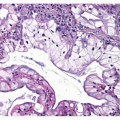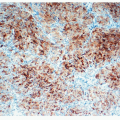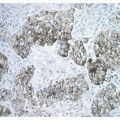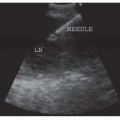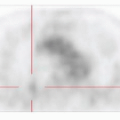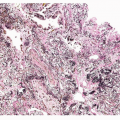Lung Cancer Stem Cells
Timothy Craig Allen
Although lung stem cells and the hypothesis of lung cancer stem cells do not fit the typical paradigm of preneoplastic and preinvasive lesions, a brief review of lung cancer stem cells is warranted in this section, as the molecular changes and other characteristics of preneoplasia are associated with lung cancer stem cells. Human beings normally possess germ cells. Populations of germinal stem cells produce eggs and sperm. Embryonic stem cells are undifferentiated totipotent cells derived from blastocysts that have the capacity to propagate indefinitely, and develop into more differentiated cell lineages both in vivo and in vitro.1,2,3,4,5,6 and 7 Originally, embryonic stem cells appeared to have the greatest potential to provide future therapeutic benefits; however, legal, ethical, and policy considerations, as well as medical and technical issues such as tumorigenicity of the embryonic stem cells, contamination with animal material, and genetic compatibility have prevented the potential benefits of embryonic stem cells from being fully explored.8,9 and 10 Nonetheless, cultures of human embryonic stem cells have reportedly been differentiated into lung epithelial-like tissue.11
ADULT STEM CELLS
Somatic, or adult, stem cells are another population of stem cells identified in human beings. Somatic stem cells have a limited capacity for self renewal and play a role in tissue self-renewal. Important for tissue repair and regeneration, somatic stem cells have been identified in a variety of tissues, including hematopoietic, neural, epidermal mammary, hepatic, mesenchymal, gastrointestinal, and pulmonary tissues. Telomeres, attached to the inner nuclear surface, are required for stability of individual chromosomes and the appropriate segregation of chromosomes during cell division. It is suspected that telomerase, important in maintaining telomere activity, is limited in somatic stem cells, thus limiting the self-renewal capacity of somatic stem cells. Adult stem cells include hematopoietic stem cells, typically found in the bone marrow, mesenchymal stem cells, and stem cells residing in specific organs, termed progenitor cells. Organ-specific progenitor cells are generally believed to aggregate in special tissue microenvironments, termed the stem cell niche.12,13,14,15,16,17,18,19,20,21,22,23,24,25,26,27,28,29,30,31,32,33,34,35,36,37,38,39 and 40 These stem cell niches are thought to be located in areas of an organ with abundant vasculature and with growth factors from surrounding cells promoting the survival and selfrenewal of the stem cells, allowing for the proper balance of self-renewal and differentiation.41 Besides for promoting survival, the stem cell niche microenvironment also appears to promote drug resistance.41,42 and 43 While still controversial, it is thought that these progenitor cell populations in the lung may arise from differentiation of embryonic stem cells; however, these cells have also been considered to possibly arise from hematopoietic stem cells or mesenchymal stem cells.44,45 and 46
CANCER STEM CELLS, LUNG STEM CELLS, AND LUNG CANCER STEM CELLS
Currently, there is evidence suggesting that both hematopoietic tumors and solid tumors are derived from organ-specific cancer stem cells, or related progenitor cells.47,48 and 49 The cancer stem cell hypothesis is generally accepted as relevant to the development of solid malignancies.50,51 Stem cell transformation into malignant cells is the origin of tumor cell populations and has only
relatively recently become the subject of much attention with the emergence of supportive evidence from the study of hematologic malignancies.52 It is thought that these antigenically distinct cancer stem cells make up a population of expanding progenitor cells that sustain the tumor mass as variably differentiated, possibly heterogeneous tumor cells; as well as a population of renewing cancer stem cells. Stem cells, self-renewing and long-lived, are the cells most likely to live long enough to accumulate sufficient molecular changes necessary for malignant transformation.41,53 As such, characterization and destruction of the terminally differentiated cells may be less important therapeutically than the identification, characterization, regulation, and destruction of the cancer stem cells.
relatively recently become the subject of much attention with the emergence of supportive evidence from the study of hematologic malignancies.52 It is thought that these antigenically distinct cancer stem cells make up a population of expanding progenitor cells that sustain the tumor mass as variably differentiated, possibly heterogeneous tumor cells; as well as a population of renewing cancer stem cells. Stem cells, self-renewing and long-lived, are the cells most likely to live long enough to accumulate sufficient molecular changes necessary for malignant transformation.41,53 As such, characterization and destruction of the terminally differentiated cells may be less important therapeutically than the identification, characterization, regulation, and destruction of the cancer stem cells.
Cancer stem cells, supposedly rare cells that have the self-renewal properties, have the pluripotentiality, and result in the production of a hierarchy of progenitor and differentiated cells as normal stem cells, have been relatively well examined in hematopoietic malignancies. Leukemia stem cells have been found to be necessary and sufficient for leukemia maintenance. Cancer stem cells have been identified in a variety of leukemias, including acute myeloid leukemia and chronic myeloid leukemia.54,55,56 and 57 Initial genetic hits have been identified in stem cells associated with hematopoietic tumors.41 Once stem cells in the lung become malignant, these cells then proliferate, dividing to form one differentiated daughter cell and one daughter stem cell, maintaining the lung cancer stem cell population. Similar findings have been shown with some solid malignancies, including brain and breast tumors.50,51,56,58 Disseminated or migrating cancer stem cells probably play a causative role in the development of metastatic disease.59 Studies also show these cancer stem cells to exhibit resistance to chemotherapy and radiotherapy.51 Lung cancers are often heterogeneous; but it is currently uncertain whether different cancer stem cell clones cause tumor heterogeneity or whether cancer stem cells have the pluripotentiality of normal stem cells.60
Rather than the existence of a single, pleuripotential stem cell population in the lung, studies have provided evidence of several stem cell populations in normal lung that are relatively specific to certain areas of the lung.29,61,62,63,64,65 and 66 Strongly CK5-immunopositive basal cells within submucosal gland ducts in the mouse trachea have been identified and are considered possible stem cells or progenitor cells involved in regeneration or repair of tracheal epithelium.61 Clara cell secretory protein expressing cells, also termed CE cells, and basal cells that line mouse bronchi may be stem cells or progenitor cells.65,67,68 The bronchioles in the mouse lung, CE cells, associated with pulmonary neuroendocrine cells, are arranged in small bodies of cells termed neuroepithelial bodies. The CE cells in the bronchioles are pollution resistant, most likely due to cellular deficiency of the drug-metabolizing enzyme CYP450 2F2.66 The bronchioloalveolar duct junction in mice has been shown to contain pollution-resistant CE cells, not associated with neuroepithelial bodies, exhibiting both alveolar epithelia type II cell marker, surfactant protein C, and Clara cell secretory protein. These cells probably play a reparative role for the terminal bronchioles, alveolar ducts, and alveoli.64 These cells were identified as stem cells due to their expression of stem cell surface markers Sca-1 and CD34. Another stem cell niche of “variant” Clara cells has been identified arising in the same location.63,64,69 A third possible stem cell population has been identified, differing from the bronchioloalveolar stem cell population noted above by their CD34 immunonegativity, and their immunopositivity with Oct-4 and SSEA-1, both embryonic stem cell markers related to self-renewal and puripotency.70,71 Oct-4 positivity suggests the possibility that bronchioloalveolar stem cells arise from Oct-4 positive neonatal lung cells.69,72 Homeostatic regulation of bronchioloalveolar stem cell niches has been associated with expression of several tumor suppressor genes.69 In mouse lung studies, stem cell niches have been identified that maintain epithelial differentiation within the airways. These niches are likely targets for lung cancer initiation and promotion.26,64,65 It is thought that there may be as many as 40 different epithelial, mesenchymal, vascular, and lymphatic endothelial and immune cell lineages in the lung.24,73 It is important to remember that “lung cancer” is actually a variety of malignant pulmonary neoplasms that arise from cells that are phenotypically different.24,26,33
Stay updated, free articles. Join our Telegram channel

Full access? Get Clinical Tree


